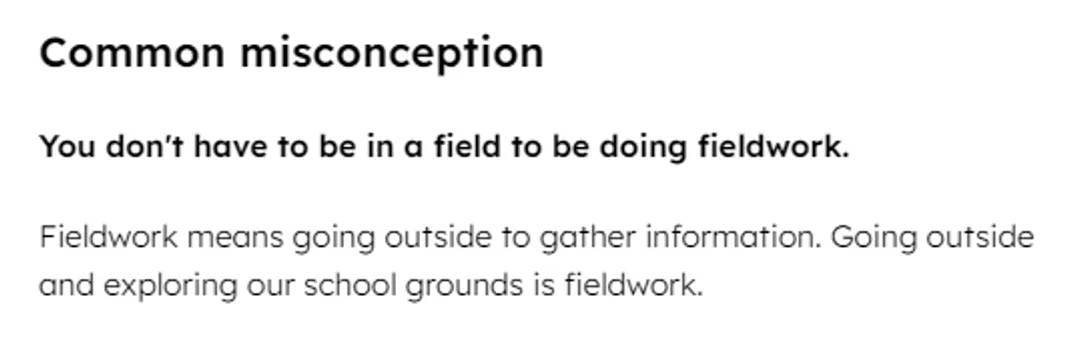
Categories
Lesson planning
30 May 2024How to address common misconceptions in lessons

Melanie McGhee
School Support Officer
Teaching is difficult. As is learning. Especially learning academic subjects. If it were easy, your pupils wouldn’t need you to guide them through their learning journey!
Consequently, it is likely that pupils will develop misconceptions about the topics you are teaching. And that different pupils develop different misconceptions. But firstly, what are they and how do you address common misconceptions?
“One in three things a student will have learned by the end of a lesson will not be known by any other pupil.”
(Graham Nuthall (2007), The Hidden Lives of Learners
A misconception in this context is a misunderstanding on the pupil’s part. If you don’t address pupils’ misconceptions, it can jeopardise the success of their learning, as it means subsequent knowledge will be built on insecure or incorrect foundations.
At best, pupils will not achieve the learning outcome of your lesson, and at worst they may fail to access future concepts within your curriculum sequence.
It’s difficult to correct misconceptions once they become embedded. Therefore it’s important to address common misconceptions before they become a barrier to your pupils’ progress.
Misconceptions are an inevitable part of learning. Some of the misconceptions your pupils have will be common across your class or your group. You may wish to scrutinise these common misconceptions more fully once the content has been taught - in order to avoid any confusion.
But, how do you do this? Here are three strategies for addressing common misconceptions in your classroom.
How to address common misconceptions
1. Plan to expose common misconceptions
You might want to anticipate what common misconceptions your pupil might have, and incorporate them into your planning.
If you are unsure what the common misconceptions are for a given topic, you could ask colleagues in order to gain an understanding of what pupils have struggled with in the past and how they planned to expose these common misconceptions. This can also help build your confidence if you’re teaching a new topic.
If you’re planning on using our teaching resources, either for inspiration or in their entirety, there is a common misconception associated with every lesson. There’s also a suggested response from the teachers who designed the resources.
That said, only you know your classes, and this is just a starting point. If you’re already familiar with your pupils, you could consider what they have found challenging in the past and plan to tackle this as part of your lesson.

This is an example of a common misconception from one of our KS1 geography teaching resources.
2. Regular checks for understanding
Using regular checks for understanding is one of the most powerful ways to catch misconceptions. Especially if you supercharge them by ensuring you get whole class feedback by using mini whiteboards for example.
It’s your diagnostic tool for checking that your pupils are on track to meet the learning outcomes for your lesson. When a check for understanding uncovers that your pupils may hold a misconception, you can quickly work to unpick and address it in the moment.
If an unexpected misconception arises that you hadn’t planned to address, this is a great opportunity to catch misunderstandings before they have the chance to foster and become embedded in long-term memory.
Checks for understanding are peppered throughout our explanations as seen in our slide decks, providing you with inspiration about what to ask to check for understanding. Take a look at our teaching resources as a model to get you started, or use them as they are.
Our prior knowledge starter quiz and assessment exit quizzes can also check for understanding and capture common misconceptions from previous teaching and from the lesson you’re teaching. How you choose to respond to this in the lesson will be down to your professional judgement and the nature of your pupils’ misunderstandings.
3. Feedback
Finally, you could use planned feedback to address common misconceptions. If you have spotted common themes in your pupils’ work, you might want to consider:
- Reteaching the topic
To make sure the misconception was addressed and that the topic was thoroughly understood, you will want to check this again afterwards. You could use the strategies mentioned earlier, such as mini-whiteboards, cold-calling, quizzing and incorrect worked examples to revisit and test where a common misconception was corrected.
You might also want to consider: was it clear, accurate and easy for your pupils to understand the first time? If not, why not? This could be the whole topic or a very precise aspect of it. It’s important that your pupils have secure knowledge before continuing. - The volume of misunderstanding
Is it a whole class that has misconceptions or just one pupil? This will determine how you give feedback and whether it warrants delivering as a whole-class or individually.
Key takeaways for addressing common misconceptions
- Misconceptions are a part of learning and you’ll often find common misconceptions within your classes. It’s important to catch them quickly -this prevents them becoming embedded in long-term memory (which makes them harder to correct!).
- Regularly check for understanding. This is important so you understand your pupil’s progress, knowledge gaps and common misconceptions.
- You can use a range of strategies to check for misconceptions. They’re your superpower to unlock pupil potential.
You might also be interested in:
- How to teach difficult topics
- Building confidence in a new subject
- Three ways to motivate pupils' learning and hook them into a new topic
- Tips to help you plan a lesson
Sign up for email updates
Sign up below to be kept updated on our latest curriculum developments and other helpful content by email. Unsubscribe at any time. Read our privacy policy.

